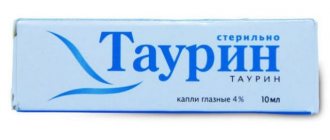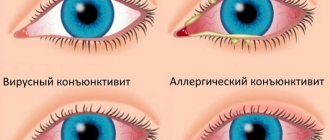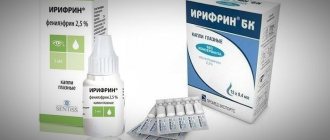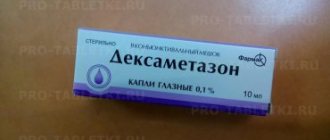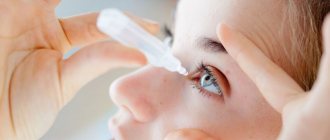Preventing refractive errors
In the structure of ophthalmological diseases, disorders of the optical systems of the eye occupy 43%. Visual acuity depends on the accuracy of the refraction of light rays by the cornea and lens. Eye drops to prevent a decrease in visual acuity will help prevent the development of myopia and farsightedness.
Prevention of myopia
With myopia (myopia), the eyeball lengthens and the retina stretches. A person can see small details up close, but in the distance they see blurry, indistinct. What drops are needed to prevent myopia?
Okovit
General strengthening agent with vitamins A, C, E, minerals Zn, Mn, Se. Indicated for visual fatigue from working at a monitor starting from the age of 12. Strengthens the blood vessels of the eyes, improves color perception. Place 2 drops in each eye 4 times a day. Contraindicated for pregnant women and allergy sufferers.
Taufon
Contains the amino acid taurine, stimulates the regeneration of eye structures, activates metabolism, improves tissue nutrition. Prescribe 1-2 drops 4 times a day. A course of drops for eye prophylaxis is 1 month, then a break for a month and repeat the course. The Russian-made product costs from 100 rubles per 10 ml bottle.
The main rule for preventing eye myopia is good lighting of the workplace, proper nutrition, rest, and relaxation of the eye muscles every hour during hard work.
Prevention of farsightedness
The vision defect progresses from the age of 30, when the lens stops changing curvature. It is difficult to see both near and far. What eye drops exist to prevent farsightedness?
Kuspavit
Vitamin-herbal complex for eyes based on plastoquinone, vitamin C, potassium sorbate. Drops increase vascular tone, enhance tissue trophism, relieve inflammation and allergies of the organ of vision. Prevents farsightedness that progresses with age. Moisturize and protect the cornea when working in dusty, smoky rooms. Apply 2 drops 3 times a day. The course cycle is up to 3 months. Do not use for children under 14 years of age. Price – 600-700 rubles for 5 ml.
Ujala
An Ayurvedic preparation including herbal extract and potassium salts. Helps clean tear ducts, relieves visual strain, and has a mild anti-inflammatory and analgesic effect. In the morning and at night, add 2 drops, close your eyes, sit calmly and relaxed for 10 minutes. Next, avoid straining your eyes for 2 hours. Preventive course – 2 months once a year. Drops are not used for viral and fungal infections of the eyes, or under contact lenses.
Regular visits to an ophthalmologist and correctly selected glasses (lenses) in the initial stage of the disease will allow you to delay age-related farsightedness.
List of the best eye drops for cataracts: the most effective remedies
A cataract is any clouding of the lens of the eye. With the development of this disease, the function of the organ of vision is impaired. At the initial stages of cataracts, conservative treatment is possible with drugs that can slow down the rate of development of pathological processes in the lens.
Why do cataracts occur?
The main theory of the occurrence of cataracts is the aging of the lens fibers. After 40 years, the processes of lipid peroxidation in the body intensify and the antioxidant protection of cells decreases.
The transparent fibers of the lens gradually begin to become cloudy. That is, the development of opacities in the lens is a physiological process that appears in all people, but at different ages.
This type of cataract is called senile cataract.
What are the signs to suspect cataracts?
In the initial stages, cataracts are manifested by slight blurred vision, the appearance of spots in front of the eyes, and a feeling of sand in the eyes. When the clouding increases in size, a decrease in vision and a change in color perception occur. The patient begins to see as if through foggy glass. With central cataracts, vision deteriorates in bright light, with peripheral cataracts - at night.
Mature cataracts are characterized by almost complete loss of vision. The background of the pupil becomes white instead of black. In this case, the patient is able to see light and distinguish day from night.
Are drops effective for cataracts?
The only treatment for mature cataracts is surgical removal of the lens and replacing it with an artificial lens.
But in the initial stages of the disease, using eye drops can slow down the process of clouding of the lens and reduce the severity of symptoms.
In addition, the use of special drops is necessary after surgery to prevent possible complications.
Types of drops
Eye drops to improve vision for cataracts vary depending on the active substance included in the drug, manufacturer, and indications. There are:
- Preparations for the treatment of the initial stages of senile cataracts.
- Means for the prevention of disease.
- Eye medications used after surgery.
Drops for the treatment of cataracts
- Oftan-katachrom (can be found under the name Katahrom).
Combined antioxidant drug with a reparative effect. Improves the exchange of nutrients between the lens and the aqueous humor of the anterior chamber of the eye, thereby reducing the rate of fiber aging. Activates cellular respiration. Oftan katachrome occupies one of the leading places in the ranking of eye drops for cataracts. - Quinax. The principle of action of this medicine is based on its ability to stimulate enzymes that resolve lens opacities.
Quinax increases the antioxidant protection of cells and slows down the process of changes in protein molecules in the lens. - Taurine. The substance improves metabolism in tissues and has a reparative effect. The composition contains an amino acid produced in the human body.
- Taufon .
The drug is an analogue of Taurine. Improves energy processes in tissues, stabilizes the functions of cell membranes. With long-term use, it restores normal metabolism in the structures of the anterior segment of the eye. - Vita-Iodurol. The medicine contains calcium, magnesium, vitamins and amino acids. Active ingredients improve blood supply to the tissues of the eyeball and prevent the deposition of protein molecules in the tissues of the lens.
- Catalin. Japanese remedy for cataracts.
The drug prevents the transition of water-soluble protein to an insoluble form. This slows down the growth of opacities in the lens. - Cataxol. The drug protects the lens fibers from oxidation and dissolves opaque protein complexes.
Drops for the prevention of cataracts
- Ujala. Indian eye drops contain only natural ingredients. The drug has antioxidant and antimicrobial effects. When taken as a course, it reduces the rate of cataract development.
- Hey Pee Wee. The medicine is a combination of propolis extract and silver purified water.
Slows down the development of degenerative processes in the lens. - Vitafacol. The product contains synthetic antioxidants. Vitafacol improves cellular respiration and metabolic processes, preventing the development of cataracts.
- Khrustalin. The medicine contains antioxidants and B vitamins.
Drops stimulate tissue regeneration and reduce the intensity of lipid peroxidation.
Medications after surgery
The duration of the recovery period after cataract surgery depends on the type of surgery.
With EEC (extracapsular cataract extraction), patients are prescribed antimicrobial, anti-inflammatory, antiseptic and regenerating drugs for a long period - about 1 month.
If the lens replacement surgery was performed through a small incision using a laser, these medications are prescribed for 1 week.
In the postoperative period the following are used:
- Signicef. An antimicrobial drug of the latest generation, classified as a broad-spectrum antibiotic. After topical application, it does not have any unwanted systemic reactions. If there are complications, the ophthalmologist may prescribe an antibiotic that acts on a specific type of microorganism.
- Diklo-F. Non-steroidal anti-inflammatory drug. Drops relieve pain, reduce the severity of inflammation and redness of the eyes. In case of severe swelling of the eyelids, the doctor may recommend longer use of drops.
- Vitabact. Antiseptic drug. Vitabact can be used for a long time, even after stopping the antibiotic.
- Korneregel. The medicine is in the form of a gel and has regenerating and moisturizing properties. The drug must be used in patients after EEC to prevent suture dehiscence. It is necessary to continue use for some time after removal of the suture material. This will speed up the healing of the cornea of the eye.
Reviews from doctors and patients
Doctors' opinions on drugs for the treatment and prevention of cataracts:
Patient reviews:
Source: https://GlazaLik.ru/preparaty/glaznye-kapli/ot-katarakty/
Drops for the prevention of cataracts
Almost a third of all ocular abnormalities are due to denaturation of the lens protein, which leads to clouding of the biological lens of the eye and visual impairment. Develops with age, progressing significantly towards 60-80 years. Eye drops to prevent cataracts will help delay the disease.
Catalin
A medicine that stops the initial stage of age-related cataracts. The active substance pyrenoxine slows down the transition of lens protein into an insoluble form. The drug kit includes a red-orange tablet and a transparent solvent. Before use, the tablet is diluted in a solvent, the resulting liquid is dripped 5 times a day, 2 drops. The prepared solution is stored for up to 20 days in a dark, cool place. The Japanese drug is offered by pharmacies for 480-500 rubles per set.
Quinax
They act on the basis of azapentacene, protecting lens proteins from oxidation and clouding, and causing the resorption of existing cloudy areas. Use 2 drops 3 to 5 times a day. Side complications - allergic reactions. The duration of use is agreed with the doctor. A 15 ml bottle will cost 400 rubles.
To some extent, you can delay the appearance of cataracts by protecting your eyes from sunlight, enriching your diet with vitamins and minerals, and giving up cigarettes and alcohol.
Steroid drugs
To relieve swelling, drugs based on glucocorticosteroids are sometimes used. These are hormonal drugs. They quickly stop the inflammatory process, relieve itching, and have an analgesic effect. Sometimes prescribed as part of complex therapy, they enhance the effect of other medications. Several inexpensive drugs are popular.
- Sofradex is a complex drug containing a glucocorticoid and an antibiotic. Relieves inflammation and swelling. Effective for infectious or allergic pathologies.
- Dexamethasone is used for acute and chronic inflammation, after injuries. The effect is noticeable after 4 hours. Can be used for a long time.
- Maxitrol is a complex drug with antibacterial action. Effective even for severe infectious and inflammatory pathologies. In this case, you need to bury it every hour.
- Prenacid has anti-inflammatory, antihistamine and vasoconstrictor effects. Do not drip for more than 10 days.
It is recommended to use glucocorticoids when other treatments are ineffective. They are prescribed after operations, injuries, severe allergic reactions, severe iridocyclitis, scleritis. Often cause systemic side effects, increased intraocular pressure and addiction. It should be used according to the instructions; therapy should not be interrupted prematurely.
Drops for the prevention of eye glaucoma
Increased intraocular pressure accounts for only 2% of visual anomalies, but is ahead of its “competitors” in the risk of optic nerve atrophy and leads to complete blindness. The main reason is a violation of the outflow of fluid inside the eyeball. Complex therapeutic measures include the prevention of glaucoma with medications.
Irifrin
Thanks to the adrenomimetic component, it dilates the pupil, stimulates the circulation of intraocular fluid, and constricts the conjunctival vessels. Contraindicated for narrow-angle and closed-angle glaucoma. Relief from attacks of increased intraocular pressure is achieved by 1-2 drops of the medicine in each eye 3-5 times a day. It is not recommended to exceed the therapeutic dose without the doctor’s knowledge. The drug from an Indian manufacturer is priced at 500 rubles per 5 ml.
Xalatan
Latanoproxt in the composition of the drug increases the outflow of aqueous humor, reducing the pressure inside the eyeball. People over 18 years of age are prescribed 1 drop of the drug into the affected eye at night. Contact lenses should be put on no earlier than 15 minutes after instillation. May cause darkening of the iris and reversible increased eyelash growth.
Vita Yodurol
Eye drops prevent cataracts and glaucoma. Calcium and magnesium chlorides activate blood circulation, eliminate congestion in the eyeball, and improve nutrition of eye tissue. Apply 1-2 drops to each eye 3 times a day. The duration of therapy is determined individually.
At risk of increased intraocular pressure are people whose close relatives suffered from glaucoma, and women over 50 years of age. Contribute to the development of vascular and metabolic pathologies (diabetes, thyrotoxicosis).
In what cases should such drugs be used?
Note! To eliminate the cause of visual impairment, you must first determine the reason why it loses its sharpness.
The most common reasons are the following:
- Constant eye strain. Occurs when you read or write in dim or improper lighting. When spending a lot of time at the computer or near the TV. If the work involves constant concentration of gaze on one, most often small, object.
- Phlebeurysm . Many people are accustomed to thinking that this disorder is characteristic only of the lower extremities. This is a misconception, as it affects many internal organs, including the eyes. There is a deterioration in the outflow of blood and disruption of the normal functioning of the eyeballs.
- Limited or poor food intake . If you do not consume micro- and macroelements necessary for the body with food, metabolic processes in the eyes are disrupted and their functions are disrupted.
- Dry eyes (dry eye syndrome). If the tear glands do not produce enough natural lubrication, the eyes quickly become tired and become susceptible to infections.
- Changes in the structure of the fundus with age. The older we get, the slower all processes in the body flow. This leads to a drop in vision levels.
If you suffer from vision diseases such as myopia, farsightedness, cataracts, etc., the pharmaceutical market is also replete with many different medications designed to improve your quality of life.
Important! For people with allergies, eye medications are a salvation from symptoms caused by external irritants. They relieve itching, redness, burning and normalize the condition of your eyes.
causing your allergy is not eliminated the use of eye drops will only have a temporary and not cumulative effect.
The use of decorative cosmetics by women can also cause unpleasant problems with the condition of such delicate and sensitive organs as the eyes.
This is due to the fact that cosmetics contain artificial dyes, fragrances and petroleum products that cause irritation to the soft tissues of the eyes.
If you suffer from any of the symptoms described above, we advise you to purchase a suitable remedy and, if possible, eliminate the source of irritation.
Preparations for the prevention of demodicosis of the eyes
The skin of the eyelids, hair follicles of eyelashes and eyebrows are susceptible to infection by microscopic mites of the genus Demodex. The affected areas are red, itchy, and covered with sticky exudate. Symptoms intensify in the heat, after a bath or hot bath. People with weakened immune systems and those who neglect personal hygiene are predisposed to infection. With age, the likelihood of the disease increases. To prevent demodicosis of the eyes, drops and ointments are used.
Tosmilen
Means for treating the skin of the eyelids. The drug is applied to the fingertips and rubbed into the eyelids with light massaging movements. The medicine causes paralysis of the limbs of the tick with subsequent death of the pathogens. Use 1 drop once a day for no more than 2-4 days.
Dexa gentamicin
Anti-inflammatory, antibacterial drops. Eliminate allergic redness, fight secondary infection with opportunistic microflora. Contraindications are fungal and viral eye infections, age under 18 years. 1-2 drops are instilled into each eye 4-6 times a day. Duration of use – 2-3 weeks.
Oftalmodek
The biologically active drug enhances the effect of antibiotics and eliminates a wide range of microorganisms. Use in combination with antibiotics, 1-2 drops 3-4 per day. The price of the drug is 45 rubles per 5 ml.
Avoid using other people's cosmetics, glasses, and contact lenses. Use Demodex complex liquid soap to wash your face. Regularly treat glasses, contact lenses, and cases for storing them with antiseptic agents.
Eye inflammation
The eyes become inflamed for various reasons. More often it is infection, dust, foreign body or injury. But inflammation can develop due to an allergic reaction, eye strain, hypothermia, or colds. Depending on the cause, this process is localized in the conjunctiva, sclera, cornea, and choroid. Based on this feature, several inflammatory eye pathologies are distinguished:
- conjunctivitis - damage to the mucous membrane, the most common group of pathologies;
- keratitis - damage to the cornea, characterized by pain, photophobia, lacrimation;
- stye - inflammation of the hair follicle;
- blepharitis - chronic inflammation of the edges of the eyelids, accompanied by burning, pain, and decreased clarity of vision;
- Iridocyclitis affects the iris and blood vessels.
Delayed treatment can lead to vision loss and other complications. Therefore, if burning, itching, redness, lacrimation, photophobia and decreased clarity of vision occur, you should consult a doctor to determine the cause of the pathology.
Eye drops for the prevention of conjunctivitis
Inflammation of the eye mucosa is caused by viruses, bacteria, fungi, allergens, and chemical agents. Predisposing factors include dirt, dust, smoke, and fumes. Prophylactic eye drops are designed to prevent inflammation.
Reticulin
Combines extracts of five herbs and antiseptics. Drops moisturize the cornea, protect against dust and the introduction of pathogenic microbes. Increases the adaptive capabilities of the organ of vision, relieves fatigue. Use a drop of the product three times a day for up to 3 months. Allergic reactions to the components of the medicine are possible.
Zorro
Moisturizing drops from chamomile and green tea extract, antioxidants, antimicrobial substances. They activate the metabolism of eye tissue, increase the elasticity of the cornea, and stimulate the restoration of optical structures. Prescribed for contact with dust, dry air, and smog on the street. 1-2 drops are instilled into each eye 3 times a day. The course of prevention is 2 months a year. You can buy 5 ml drops of Zorro for 700 rubles.
Antibiotics, bacteriostatics
Preparations in this group include active ingredients of synthetic or natural origin that are harmful to pathogenic microorganisms. The range of their use in ophthalmic treatment is quite wide. They are indicated in the treatment of bacterial blepharitis, conjunctivitis, barley, dacryocystitis, keratitis and other acute and chronic infectious eye lesions.
Treatment agents are divided into two large groups:
- Antibacterial (aminoglycosides, fluoroquinolones).
- Sulfanilamide.
The choice of one or another drug is made by a specialist, taking into account age, spectrum of exposure, expected tolerability, and sensitivity of the infection to the drug.
Tsipromed, Floxal, Signitsef
Eye drops with the main component of ciprofloxacin hydrochloride, a broad-spectrum fluoroquinolone antibiotic. Suppresses reproducing and dormant bacteria.
They give a high absorption rate and reach their maximum concentration after 2 hours, maintaining it for up to 6 hours.
Indicated in the treatment of infectious and inflammatory diseases of the eyes and appendages: conjunctivitis, keratitis, uveitis, blepharitis.
The dosage of fluoroquinolone drugs is determined by the doctor. The course of treatment lasts 7 days.
Dilaterol, Tobrex
Ophthalmic solutions with aminoglycosides, where tobramycin sulfate is included as the main component.
The local antibiotic acts on streptococcus, staphylococcus, Klebsiella, diphtheria and Escherichia coli.
Indicated for infectious eye lesions by pathogenic microorganisms sensitive to tobramycin sulfate in all categories of patients, including newborns.
Course of treatment: from 7 to 10 days.
Sulfonamide bacteriostatic drugs are prescribed at the initial stage of infection. They inhibit the growth and reproduction of pathogenic microorganisms and, in addition to the bacteriostatic effect, have a keratoplastic effect: they restore the outer epithelial cell layer.
Albucid
The active ingredient is sodium sulfacide (sulfacetamide).
The drug is available in two dosages of an aqueous solution of 5 and 10 ml:
- 20% children's.
- 30% adult.
Eye drops provide a local antimicrobial effect against Escherichia coli, gonococcus, streptococcus, staphylococcus, and chlamydia.
It is used for infectious and inflammatory diseases of the anterior part of the eye: purulent conjunctivitis, blepharitis, corneal ulcers. For prophylactic purposes it is used to prevent infections in newborns.
The course of treatment with the drug is continued until symptoms disappear completely, with daily instillations every 4 hours.


